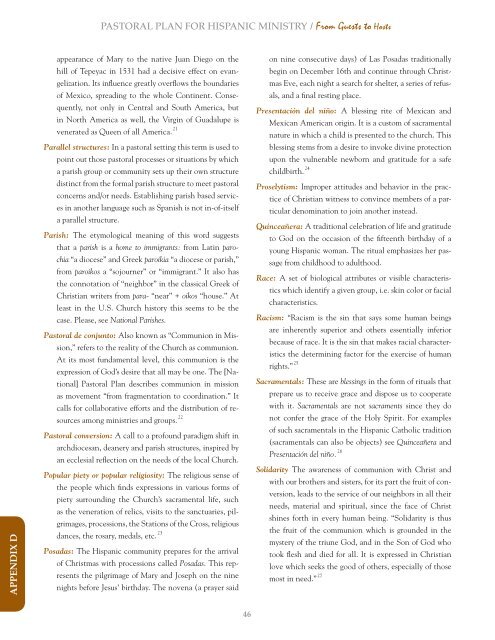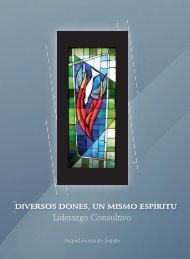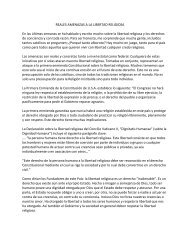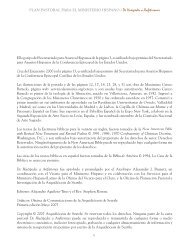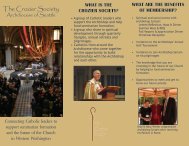Pastoral Plan for HisPanic Ministry / From Guests to Hosts Hispanic ...
Pastoral Plan for HisPanic Ministry / From Guests to Hosts Hispanic ...
Pastoral Plan for HisPanic Ministry / From Guests to Hosts Hispanic ...
You also want an ePaper? Increase the reach of your titles
YUMPU automatically turns print PDFs into web optimized ePapers that Google loves.
<strong>Pas<strong>to</strong>ral</strong> <strong>Plan</strong> <strong>for</strong> <strong>Hispanic</strong> <strong>Ministry</strong> / <strong>From</strong> <strong>Guests</strong> <strong>to</strong> <strong>Hosts</strong>Appendix Dappearance of Mary <strong>to</strong> the native Juan Diego on thehill of Tepeyac in 1531 had a decisive effect on evangelization.Its influence greatly overflows the boundariesof Mexico, spreading <strong>to</strong> the whole Continent. Consequently,not only in Central and South America, butin North America as well, the Virgin of Guadalupe is21venerated as Queen of all America.Parallel structures: In a pas<strong>to</strong>ral setting this term is used <strong>to</strong>point out those pas<strong>to</strong>ral processes or situations by whicha parish group or community sets up their own structuredistinct from the <strong>for</strong>mal parish structure <strong>to</strong> meet pas<strong>to</strong>ralconcerns and/or needs. Establishing parish based servicesin another language such as Spanish is not in-of-itselfa parallel structure.Parish: The etymological meaning of this word suggeststhat a parish is a home <strong>to</strong> immigrants: from Latin parochia“a diocese” and Greek paroikia “a diocese or parish,”from paroikos a “sojourner” or “immigrant.” It also hasthe connotation of “neighbor” in the classical Greek ofChristian writers from para- “near” + oikos “house.” Atleast in the U.S. Church his<strong>to</strong>ry this seems <strong>to</strong> be thecase. Please, see National Parishes.<strong>Pas<strong>to</strong>ral</strong> de conjun<strong>to</strong>: Also known as “Communion in Mission,”refers <strong>to</strong> the reality of the Church as communion.At its most fundamental level, this communion is theexpression of God’s desire that all may be one. The [National]<strong>Pas<strong>to</strong>ral</strong> <strong>Plan</strong> describes communion in missionas movement “from fragmentation <strong>to</strong> coordination.” Itcalls <strong>for</strong> collaborative ef<strong>for</strong>ts and the distribution of re-22sources among ministries and groups.<strong>Pas<strong>to</strong>ral</strong> conversion: A call <strong>to</strong> a profound paradigm shift inarchdiocesan, deanery and parish structures, inspired byan ecclesial reflection on the needs of the local Church.Popular piety or popular religiosity: The religious sense ofthe people which finds expressions in various <strong>for</strong>ms ofpiety surrounding the Church’s sacramental life, suchas the veneration of relics, visits <strong>to</strong> the sanctuaries, pilgrimages,processions, the Stations of the Cross, religious23dances, the rosary, medals, etc.Posadas: The <strong>Hispanic</strong> community prepares <strong>for</strong> the arrivalof Christmas with processions called Posadas. This representsthe pilgrimage of Mary and Joseph on the ninenights be<strong>for</strong>e Jesus’ birthday. The novena (a prayer saidon nine consecutive days) of Las Posadas traditionallybegin on December 16th and continue through ChristmasEve, each night a search <strong>for</strong> shelter, a series of refusals,and a final resting place.Presentación del niño: A blessing rite of Mexican andMexican American origin. It is a cus<strong>to</strong>m of sacramentalnature in which a child is presented <strong>to</strong> the church. Thisblessing stems from a desire <strong>to</strong> invoke divine protectionupon the vulnerable newborn and gratitude <strong>for</strong> a safe24childbirth.Proselytism: Improper attitudes and behavior in the practiceof Christian witness <strong>to</strong> convince members of a particulardenomination <strong>to</strong> join another instead.Quinceañera: A traditional celebration of life and gratitude<strong>to</strong> God on the occasion of the fifteenth birthday of ayoung <strong>Hispanic</strong> woman. The ritual emphasizes her passagefrom childhood <strong>to</strong> adulthood.Race: A set of biological attributes or visible characteristicswhich identify a given group, i.e. skin color or facialcharacteristics.Racism: “Racism is the sin that says some human beingsare inherently superior and others essentially inferiorbecause of race. It is the sin that makes racial characteristicsthe determining fac<strong>to</strong>r <strong>for</strong> the exercise of human25rights.”Sacramentals: These are blessings in the <strong>for</strong>m of rituals thatprepare us <strong>to</strong> receive grace and dispose us <strong>to</strong> cooperatewith it. Sacramentals are not sacraments since they donot confer the grace of the Holy Spirit. For examplesof such sacramentals in the <strong>Hispanic</strong> Catholic tradition(sacramentals can also be objects) see Quinceañera and26Presentación del niño.Solidarity The awareness of communion with Christ andwith our brothers and sisters, <strong>for</strong> its part the fruit of conversion,leads <strong>to</strong> the service of our neighbors in all theirneeds, material and spiritual, since the face of Christshines <strong>for</strong>th in every human being. “Solidarity is thusthe fruit of the communion which is grounded in themystery of the triune God, and in the Son of God who<strong>to</strong>ok flesh and died <strong>for</strong> all. It is expressed in Christianlove which seeks the good of others, especially of those27most in need.”46


